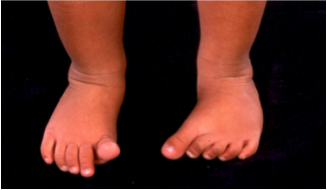In-Toeing Out-Toeing
When the foot (or feet) turns inward or outward instead of pointing straight ahead when the child is standing with the legs straight, the foot posture is called, in-toeing (sometimes referred to as ‘pigeon-toed’) or out-toeing respectively.
In-toeing (pigeon-toed) is common in young children with causes being at the hip, below the knee or the feet. Clinical assessment can determine which is the most likely. Most resolve by 10 years of age.
In-toeing with pain, swelling or a limp should be evaluated by orthopaedic surgeon.
The three common causes of in-toeing in young children are ‘rotated’ thigh bone (persistent femoral anteversion), ‘rotated’ lower limb below the knee, shin (tibial torsion) and curved foot (metatarsus adductus).
Hips
Persistent Femoral Anteversion - the rotation involves the whole leg and is most obvious when the child is able to sit in a ‘w’ position on the floor, or to lie prone with their legs markedly internally rotated.
Gait examination shows an apparent inward rotation of entire leg. This is common between 3 and 8 years of age and most commonly affects girls more than boys (2:1).
Lower Leg
Internal Tibial Torsion - the rotation is below the knee. Onset is usually after the child has started walking and usually resolves by 3 years.
Feet
Metatarsus Adductus - the legs are straight but the mid-foot is rotated.
Metatarsus adductus improves with age but if persists beyond 6 to 9 months of age and or is associated with rigid foot, then referral to paediatric orthopaedics is warranted. Serial casting may be of value for the rigid persistent types.
Photo: Metatarsus Adductus.

Indications for referral (to paediatric orthopaedics):
- Changes are extreme or persistent or there is a rigid foot.
- There is associated pain.
- There are functional problems (clumsy and prone to falling).
Out-Toeing
The feet are turned outwards when the child is standing, walking and running.
This usually resolves by 4 years of age.
Referral (urgent) is necessary if there is recent onset limp and/or pain (this may suggest a hip problem, for example Slipped Capital Femoral Epiphysis).

